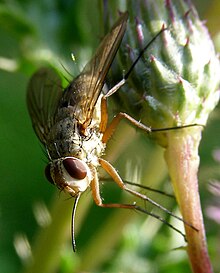Prosena siberita
| Prosena siberita | |
|---|---|

| |
| Prosena siberita | |
| Scientific classification | |
| Domain: | Eukaryota |
| Kingdom: | Animalia |
| Phylum: | Arthropoda |
| Class: | Insecta |
| Order: | Diptera |
| Family: | Tachinidae |
| Subfamily: | Dexiinae |
| Tribe: | Dexiini |
| Genus: | Prosena |
| Species: | P. siberita
|
| Binomial name | |
| Prosena siberita | |
| Synonyms | |
| |
Prosena siberita is a species of fly in the family Tachinidae.[8][9]
Distribution
[edit]This species is present in most of Europe,[10] Central Asia, Japan, Mongolia, China, Russia, Transcaucasia, India, Indonesia, Malaysia, Myanmar, Nepal, Philippines, Ryukyu Islands, Sri Lanka, Taiwan, Australia and New Caledonia. It has been introduced and established in United States.[11][12] The earliest introduction occurred in 1925, when numerous specimens were released in New Jersey for the purpose of establishing a local population to combat the spread of the Japanese beetle.[13]
Description
[edit]
Prosena siberita can reach a body length of 7.5–10.5 millimetres (0.30–0.41 in).[14] These flies have a grey dusted, fuscous or testaceour body. In males the abdomen is largely testaceous, while in females it is fuscous, densely grey dusted. Thorax shows some yellowish hairs. They have a very long and slender proboscis that they keep hinged under the body. The length of the proboscis is longer than the height of the head. Palpi are highly reduced. Eyes are reddish-brown and bare. Femora are reddish. Wings are hyaline, yellowish-brown at the base.[14][15]
Biology
[edit]Prosena siberita is a univoltine species. Adults are harmless nectar feeders on flowers of various plants (Clematis gouriana, Gnaphalium sp., Tecoma castanifolia, Seseli libanotis, Patrinia scabiosifolia, etc.).[16] Their larvae parasitize the larvae of various Sericini, Melolonthini and Anomalini scarab beetles[14] (Popillia japonica, Adoretus, Anomala, Leucopholis species).[14][15][17]
Bibliography
[edit]- James E. O'Hara, Hiroshi Shima, & Chuntian Zhang. "Annotated Catalogue of the Tachinidae (Insecta: Diptera) of China." Zootaxa 2190 (2009): 1–236.
- Sabrosky and Arnaud, in Stone et al., 1965, Catalog of the Diptera of America north of Mexico, p. 987.
References
[edit]- ^ a b Fabricius, J.C. (1775). Systema entomologiae, sistens insectorum classes, ordines, genera, species, adiectis synonymis, locis, descriptionibus, observationibus. Flensbvrgi et Lipsiae [= Flensburg & Leipzig]: Kortii. pp. [32] + 832. Retrieved 20 February 2021.
- ^ Townsend, C.H.T. (1926). "Fauna sumatrensis. (Beitrag No. 25). Diptera Muscoidea II". Supplementa Entomologica. 14: 14–42.
- ^ a b c Rondani, C. (1861). Dipterologiae Italicae prodromus. Vol. IV. Species Italicae. Pars tertia. Muscidae Tachininarum complementum. Vol. IV. A. Stocche, Parmae. pp. 174 pp.
- ^ Egger, J. (1860). "Beschreibung neuer Zweifugler. (Fortsetzung)". Verh. Zool.-bot. Ges. Wien. 10: 795–802. Retrieved 11 March 2022.
- ^ Wiedemann, C.R.W. (1819). "Beschreibung neuer Zweiflügler aus Ostindien und Afrika". Zoologisches Magazin. 1 (3): 1–39. Retrieved 20 November 2022.
- ^ Fabricius, J.C. (1794). Entomologia systematica emendata et aucta. Vol. 4. Hafniae [=Copenhagen]: C. G. Proft. pp. [6] + 472 + [5] pp.
- ^ Gmelin, J.F. (1790). Caroli a Linne, Systema naturae per regna tria naturae, secundum classes, ordines, genera, species; cum caracteribus, differentiis, synonymis, locis. Editio decima tertia, aucta, reformata [= Ed. 13.] Vol. 1: Regnum Animale. Vol. Tom. 1 Pars. 5. Lipsiae [= Leipzig]: G.E. Beer. pp. Pt 5, Pp. 2225-3020. Retrieved 8 December 2022.
- ^ O’Hara, James E.; Henderson, Shannon J.; Wood, D. Monty (5 March 2020). "Preliminary Checklist of the Tachinidae (Diptera) of the World" (PDF). Tachinidae Resources. Retrieved 1 January 2024.
- ^ "Prosena siberita (Fabricius, 1775)". BioLib. Retrieved 2022-03-10.
- ^ "Prosena siberita (Fabricius, 1775)". Fauna Europaea. Retrieved 2022-03-10.
- ^ "Species details: Prosena siberita (Fabricius, 1775)". www.catalogueoflife.org. Retrieved 2022-03-10.
- ^ O'Hara, James E.; Cerretti, Pierfilippo (2016). "Annotated catalogue of the Tachinidae (Insecta, Diptera) of the Afrotropical Region, with the description of seven new genera". ZooKeys (575): 1–344. Bibcode:2016ZooK..575....1O. doi:10.3897/zookeys.575.6072. PMC 4829880. PMID 27110184.
- ^ Howard, Leland Ossian (1925). Report of the Entomologist. Washington D.C.: United States Department of Agriculture, Bureau of Entomology and Plant Quarantine. p. 7.
- ^ a b c d Robert Belshaw "Tachinid Flies, Diptera: Tachinidae", Handbooks for the Identification of British Insects Vol. 10, Part 4a(i), page 108, Royal Entomological Society of London, 1993.
- ^ a b Heinrichs, E.A. (1994). Biology and management of Rice Insects. Wiley Eastern Limited. ISBN 9788122405811.
- ^ Tukaram Vithalrao, Sathe; Bhoje, Prakash Maruti; Desai, Abhijit Somanrao (2014). Floral host plants for Tachinid flies (Diptera: Tachinidae) from Kolhapur and Satara districts, India. Department of Zoology, Shivaji University – via ResearchGate.
- ^ The parasites of Popillia japonica in Japan and Chosen (Korea), and their introduction into United States United States of Agriculture – Dept. Bull. n. 1429
